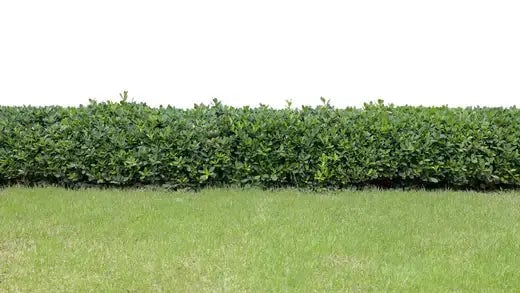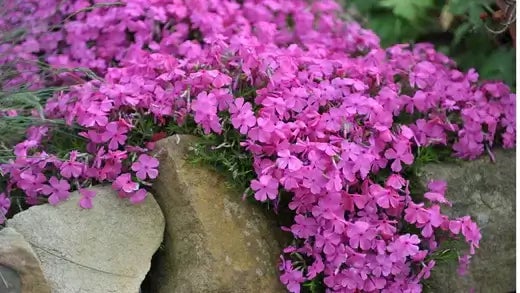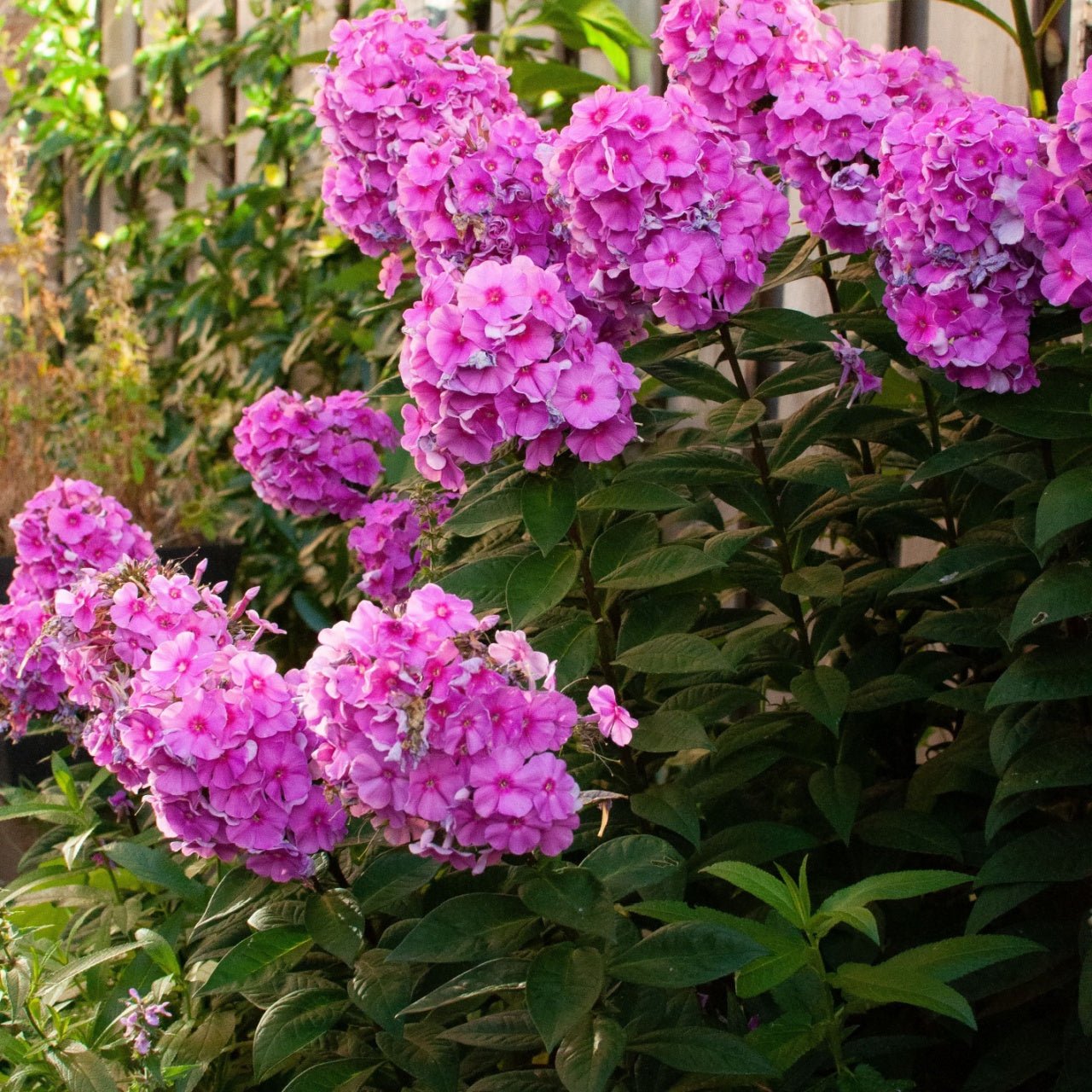Creeping phlox is a versatile and vibrant ground cover plant
Scientifically known as Phlox subulata, It has captured the hearts of garden enthusiasts with its stunning displays of color and its ability to transform landscapes. With its low-growing habit, dense mat of flowers, and adaptability to various conditions, creeping phlox has earned its place as a cherished asset in landscaping. From cascading down rock walls to carpeting open spaces with a riot of hues, here's a detailed exploration of the many landscaping uses of creeping phlox.
Rock Garden Masterpiece:
Creeping phlox is a rock garden's best friend. Its ability to hug and cascade over rocks, stones, and boulders creates a captivating visual contrast between its soft blooms and the rugged textures of the rocks. This plant adds a touch of beauty and color to rocky landscapes, turning them into picturesque retreats.
Hillside Erosion Control:
One of the practical benefits of creeping phlox is its erosion control capabilities. Its dense mat of foliage is a natural barrier against soil erosion on slopes or embankments, stabilizing the terrain and preventing soil runoff during heavy rains.
Pathway Perfection:
Planting creeping phlox along pathways and walkways can create a soft, welcoming border. As it spreads and flourishes, it lends a touch of whimsy to the edges of your paths, making each step a journey through a colorful tapestry.
Driveway Delight:
Like pathways, creeping phlox to line driveways adds color and beauty to an often overlooked area. The vibrant blooms can make even the most mundane drive a scenic experience.
Cascading Containers:
Creeping phlox is an excellent option for container gardening. Planted in hanging baskets or containers, it spills over the edges in a cascade of flowers, creating a striking display of colors and textures that can embellish patios, balconies, or porches.
Wall of Color:
Vertical surfaces like walls, fences, and retaining walls can be transformed into living tapestries with creeping phlox. As the plant grows and spreads, it envelops these surfaces with a vibrant layer of blooms, infusing them with life and color.
Poolside Paradise: For those lucky enough to have a pool, creeping phlox can enhance the area around it. Planting this ground cover near the pool's edge can soften the hardscape, adding a touch of serenity and natural beauty to the surroundings.
Lush Ground Cover:
Blanket open areas with a carpet of creeping phlox to create a sea of color. This approach works particularly well in large landscapes or open fields where a burst of color is desired. Creeping phlox creates a visual spectacle that can transform ordinary spaces, whether in a single hue or a mix of shades.
Wildlife Attractor:
Creeping phlox's profusion of blooms doesn't just delight human eyes; it also attracts pollinators like bees and butterflies. By incorporating this ground cover into your landscape, you're enhancing its aesthetic appeal and providing a valuable food source for essential pollinators.
Contrast with Other Plants:
Pairing creeping phlox with other plants can result in stunning visual combinations. Mixing it with taller perennials or shrubs can create layers of height and texture while contrasting colors can create a dynamic and vibrant interplay of hues.
Border Brilliance:
Define garden beds and borders with the colorful edge of creeping phlox. Its low stature makes it an ideal border plant, adding structure and delineation to your landscaping design.
Scented Ground Cover:
Aside from its visual beauty, creeping phlox can offer a delicate fragrance, depending on the variety. Placing it near seating areas or windows allows you to enjoy the sight and scent of these lovely blooms.
Drought-Tolerant Landscaping:
Creeping phlox is known for its resilience and adaptability to various soil types. Its tolerance for drought makes it an ideal choice for xeriscaping or water-wise landscaping, helping you create a beautiful garden while conserving water.
Cottage Garden Charm:
Creeping phlox is a must-have if you're aiming for a cottage garden aesthetic. It's cottage-like, profuse blooming and sprawling growth pattern lend themselves perfectly to this romantic and charming garden style.
Early Spring Elegance:
Creeping phlox is often one of the first plants to bloom in early spring, bringing a burst of color to your garden when it's most needed after the winter months. Its cheerful flowers can lift your spirits and signal the arrival of the growing season.
Under Trees and Shrubs:
Planting creeping phlox under trees or among shrubs can create enchanting vignettes. The way it can thrive in partial shade makes it suitable for areas where other plants might struggle due to limited sunlight.
Cutting Garden
Accent: Incorporate creeping phlox into your cutting garden to provide a low-growing accent that can be used in floral arrangements. Its dainty blooms, and vibrant colors can add a touch of elegance to bouquets and indoor decor.
Balcony Beauty:
For urban dwellers with limited outdoor space, creeping phlox can thrive in containers on balconies. Its cascading growth habit spills over the edges, transforming your patio into a vibrant oasis.
Naturalistic Landscaping:
Embrace a realistic approach by planting creeping phlox among other native or wildflowers. This creates a seamless transition between your garden and the surrounding natural environment.
Ground Cover for Wildlife Gardens:
For those interested in creating wildlife-friendly gardens, creeping phlox offers food and habitat for small creatures. Its dense mat provides shelter for insects and other critters, contributing to the overall health of your ecosystem.
In conclusion, the versatile and visually striking creeping phlox offers a plethora of landscaping uses that can boost the beauty and functionality of your outdoor spaces. Whether it's gracing rocky terrain, enhancing pathways, cascading from containers, or adding color to open areas, this ground cover plant is a dynamic asset in gardening and landscaping. With its adaptability, lush blooms, and myriad uses, creeping phlox invites you to experiment with creativity and design to achieve breathtaking results in your landscape.
How to Successfully Plant and Grow Creeping Phlox
Creeping phlox (Phlox subulata) is an evergreen perennial groundcover plant that enchants with its early spring flowers and adaptable landscaping uses. Creeping phlox serves well as a ground cover for rock gardens and borders. It establishes dense mats that prevent soil erosion while suppressing weeds and acts as an attractive filler between stepping stones. Creeping phlox demonstrates strong adaptability across numerous growing environments but reaches optimal growth with proper site selection and planting methods. Discover the top techniques for growing a thriving carpet of creeping phlox in your yard.
Selecting a location that fulfills the plant’s essential needs should be your initial step. Creeping phlox needs full sun exposure of at least six hours daily to generate its vibrant flower display, including shades of pink, purple, and white. Partial shade conditions will lead to diminished flowering performance in creeping phlox. Creeping phlox requires soil that drains effectively and maintains a pH between 6.0 and 8.0, which should be slightly acidic to neutral. Improving drainage and aeration while lessening root rot chances in heavy clay-based soil gardens can be achieved through soil amendment with compost and coarse sand or other organic materials.
Excavate your chosen planting area by eliminating weeds and debris and digging out any substantial stones present. Aerate the surface layer of soil to several inches deep, which will enhance root growth and enable better water absorption. Add two inches of compost or decomposed manure to improve soil structure. Soil amendment becomes essential when you plant on slopes or erosion-prone areas because it helps to anchor roots and secure plant placement.
Plant creeping phlox at intervals of twelve to eighteen inches apart. Over time, they will slowly extend their reach between the gaps to form a complete floral tapestry. Make holes big enough to fit the root balls when putting nursery phlox in the garden, and make sure the crown stays at ground level or just above it. Firm the soil around the plants gently and provide ample water to help establish their position in the ground. The roots of new plants form strong bonds with the soil when they receive one to two inches of water each week during their first few weeks. Creeping phlox needs less water after establishment but particularly benefits from moderate rainfall locations.
The primary maintenance strategy for creeping phlox involves applying proper fertilization methods and effective pruning techniques. Introduce slow-release balanced fertilizer or compost during spring when new growth appears and strengthen blooms and foliage. Excessive fertilization causes too much leaf growth, which hinders flower production. Pruning plants after they flower enables the preservation of their shape and stimulates a more abundant bloom display in the upcoming spring. To maintain a tidy and compact appearance of phlox, you should remove dead flowers and extend stems that have sprawled out.
Although creeping phlox exhibits strong resistance to pests and diseases, it requires monitoring for spider mites and powdery mildew, especially in warm, humid climates or areas with poor air circulation. Proper plant spacing and soil-level watering reduce common gardening problems. Your garden will showcase vibrant floral displays annually when you select appropriate planting sites and prepare the ground well, combined with attentive plant care. This perennial plant stands out in garden designs because it provides aesthetic appeal and practical coverage while maintaining its hardiness and versatility.
Read more

Adding bushes and shrubs to your garden can transform your outdoor space into a luxurious haven. These plants offer diverse colors, textures, and sizes, creating visual interest and enhancing the l...

Attracting hummingbirds to your garden can be a great way to add color and movement to your outdoor space. To create a welcoming habitat for these fascinating pollinators, providing a variety of ne...




